biography
OWEN MORAN
 Owen Moran was born in Birmingham, England on October 4th, 1884.
Owen Moran was born in Birmingham, England on October 4th, 1884.
Birmingham in the 1890’s was already England’s second city, a gritty factory town nearing three quarters of a million people. The population of such a burgeoning population center, both wealthy and poor, were attracted by travelling fairs and booths for amusement.
These ‘booths’ were usually wooden wagons hauled from place to place by horses where they would set up to give performances. Popular booths of the day included such attractions as The World’s Tallest Man and such fare. Among these booths were ones specializing in boxing, and it was in these boxing booths at the end of the 19th century that one would find a teenage Owen Moran already plying his trade. He is said to have started working in the booths at the age of fifteen.
For the shows, the booth would fill with spectators, and Moran would give an exhibition, normally taking on men from the audience much older and bigger. The pay consisted of what could be collected from the crowd. In order to make enough money to get by, Moran likely was putting on a lot of ‘shows’ in his youth, sometimes daily, sometimes more than one show a day.
It was at one of these booth shows that Moran came to be noticed by a wealthy patron of the sport of boxing. The patron, known as Captain Cleveland, was not only taken by Moran’s prowess with his fists, but he also appreciated the young man’s naïve nature and humility. Moran had apparently wanted to be a boxer. There is a story told by Cleveland when he was reminiscing about that first meeting with Moran. Cleveland asked Moran about his family and if he had fighting roots. He states “Owen told me he did, that his mother was well known for being able to beat two ordinary men at once, or clear out a pub within 10 minutes”.
Cleveland set up a boxing match for Moran against Digger Stanley for a 20 round bout. The match was in Birmingham on June 17th, 1901. Moran’s official record shows at least one match before this, and there are likely others, as working in the booths may have gotten him paying fights that have not been found, but the match with Stanley was his first bout after coming into contact with Cleveland. Weighing just 106 lbs, Moran went the distance in taking a loss, but probably more importantly, he impressed and made the Captain look good.
Cleveland took care of his charge, getting him the managerial help of Charley Harvey, and Harvey would keep getting attention for Moran.
His next match was against Harry Slough, who was known as a local champion and had far more professional bouts than Moran. The fight went down on October 9th, 1901 in Leicester, where Slough had a following. Moran went the full 15 rounds with Slough, and before the end of the fight, he had won over both the judges and the audience as he was the aggressor in the later stages.
Moran spent the next several years honing his craft and fighting frequently. On October 17th, 1904 he met up with the legendary George Dixon for a match at the Covent Garden National Sporting Club. Dixon, a former Bantamweight and Featherweight World Champion had been fighting in England as he neared the end of his tragic career and life. Moran would win a 6 round decision over Dixon.
Roughly six months later, after a handful of additional fights including three wins on a tour of Glasgow, Scotland, Moran was off to the United States.
Moran would land in Philadelphia, where he would take on Danny Dougherty in a six round bout at the Knickerbocker Athletic Club on May 12th, 1905. Dougherty, who was known as a big puncher, was outworked by Moran, who won a Newspaper Decision. Moran had etched another memorable performance, and he let the American Boxing circles know he had arrived.
If his words, which earned him descriptions as ‘cocky’, didn’t impress, his next bout was sure too. In a whirlwind three days after the Dougherty fight, the northeast’s boxing circles had arranged a private bout for Moran. He was to face Monte Attell, brother of the great Featherweight Champion Abe Attell and a highly skilled boxer in his own right at Tom O’Rourkes Gym on East 24th Street in New York on May 15th. Moran would beat Attell on points over 20 rounds, leaving an indelible mark on the American boxing scene. One account simply reads ‘Moran made hash out of Monte.’
Moran returned to England, where he went undefeated in over a dozen fights over the next fifteen months. All the while, Moran would be planning a return trip across the Atlantic in pursuit of boxing glory. The time would come soon enough, and Moran was crossing ‘the pond’ again.
Moran fought using the nickname “The Fearless” throughout career, and to a certain extent his trip to America with lofty goals was the embodiment of being ‘Fearless’. He likely didn’t expect an easy time, nor would he ever ask for an easy time throughout his long career.
Moran would stop off in Philadelphia for a 6 round bout against Tommy O’Toole on October 19th, 1907, but his real goal was to head to the west coast and the lucrative boxing scenes there. After notching a decision win over O’Toole, his next bout would be at San Francisco’s famed Dreamland Rink on November 22nd, 1907 against Frankie Neil, a well-regarded local fighter who claimed a state title.
The match was set for twenty rounds, but by the sixteenth, the local police were ready to step in and stop the fight. In came the sponge from Neil’s corner, signifying he had had enough. Moran looked all the more impressive, as at 5’4 inches tall, he appeared a lot smaller than Neil.
The American boxing scene was in an uproar over the little British fighter who was backing up all his big talk with win after win. A match was set up with Featherweight champion Abe Attell. Attell was from the San Francisco area and was said to know Frankie Neil quite well. For Attell, he most certainly knew about the drubbing Moran had given his brother Monte a few years back in New York as well. Attell agreed to put the World Featherweight title on the line, and Monte would be in his corner.
Moran met Attell in Colma, California at Jim Coffroth’s Arena on New Year’s Day 1908. Attell, as was customary for a champion, had certain conditions, including a 120 lb weight limit and naming Jim J. Jeffries as the referee. Moran agreed to all of Attell’s conditions, though one report tells of the savvy and not always scrupulous Attell being a stickler for the 120 lb limit, which Moran failed to make the first time, at 11 AM. Moran struggled to make the weight throughout the day, and in the end Attell received a $250 bonus to fight Moran, who missed the weight by a shade. More than likely, Attell was content that he had taken a physical toll on his opponent before the match even started, and he pocketed and extra $250. Abe liked to roll that way!
Attell dominated the early rounds of the fight, though Moran showed occasional signs of life. Moran’s corner however, noticed that their man’s normally limitless reserves of energy had been taxed by Attell’s grueling weigh cut demands. The story goes that between the 12 and 13th rounds, the corner gave Moran sips of bouillon soup, which seemed to awaken the dehydrated Moran, who came alive after. The match would end in a draw, but Moran had fought back after likely losing the first 12 rounds, showing that the world champion was not above his league.
Almost immediately, Moran began a campaign for a rematch, feeling he deserved another shot at the World title. Moran would return to New York to face Ad Wolgast on April 7th, 1908. Wolgast was a Midwest prospect looking to make a splash in New York who would later be a Lightweight World Champion, but on that day Moran would go home with the Newspaper Decision after 6 rounds of hard fought action. Moran’s confidence grew, and he was succeeding against very hard competition. The ‘Yankees’ weren’t doing Moran any favors.
Moran returned briefly to England, but was back in California for a September 7th, 1908 return match against Abe Attell for the Featherweight Title at San Francisco’s Mission Street Arena. Once again, Attell made nothing easy for Moran, demanding the match be 20 rounds of 25, which was the norm. No doubt he remembered the even split over 25 with Moran in their last meeting. The match was eventually settled at 23 rounds, however after the match there was little difference between the two fighters, and the match was another draw.
Moran would stay in the United States looking for a shot at a world title. In the lower weight classes, it had been some time since a British fighter had held a world title, and Moran had to feel he was close after his nearly 50 rounds with World Champion Attell left nothing decided. Brash and hard living, Moran would take the perhaps the hardest rout, taking on anyone the Americans threw at him.
Moran stayed on the West Coast for one more fight, a 20 rounder against “Cute” Eddie Hanlon. Though Hanlon’s best days were behind him, Hanlon was no slouch. Moran won the twenty rounder and headed to the back to the east coast, where he would stay for the next few years.
Upon his return east, he took two matches five days apart. On December 9th, 1908 he met Tommy O’Toole in Philadelphia and on the 14th he fought Frankie Neil in Boston. Both were return matches, and both resulted in wins for Moran.
Entering 1909, Moran kept a blistering pace of fights. On January 29th, he faced ‘Harlem’ Tommy Murphy in New York, then on February 9th he faced the very experienced Matty Baldwin in Boston. Moran won these two engagements, and he would go on to face both men multiple times over the course of the next year, winning three fights and losing one to both men as 1909 became 1910. Moran kept himself in the title picture, earning begrudging respect as a truly dangerous fighter in the lighter weights.
In February of 1910, Ad Wolgast captured the World Lightweight title from Battling Nelson in a grueling 40 round bout that grabbed headlines around the world. With a win over Wolgast two years back on his record, Moran now had the World Lightweight title in his sights as well.
On April 1st, 1910, Moran would meet Abe Attell for a third time in the Bronx and on June 24th, he would meet Attell a fourth time at Naud Junction Pavilion in Los Angeles. The two would meet again on November 9th, 1910 for the 5th and final time. Attell was still the Featherweight Champion of the World, but the title was not in play for these fights. Attell was a crafty veteran of boxing circles on both coasts, and he understood each fight with Moran would be tough. And Moran would make it tough, as Attell is credited with two close Newspaper Decisions that some saw as draws, and the third fight was an official draw. Attell, considered by most among the all-time greats, never established himself as clearly better than Moran over 74 rounds.
Moran kept on fighting. On April 29th, 1910 he fought Tommy McCarthy at the Dreamland Rink in San Francisco. The brutal bout would go sixteen of the scheduled twenty rounds before Moran landed the KO blow. McCarthy died the next day as a result of the punishment dished out by Moran, resulting in legislation against the sport of boxing in California. Moran, many of the corner men, including McCarthy’s brothers as well as the referee and several others were arrested. Moran reportedly wept while jailed, spending roughly two weeks behind bars before being released when the death was ruled accidental by the local coroner. The fatal blow was deemed to be McCarthy hitting the back of his head on the mat as he landed, not the blow from Moran.
Moran continued to look for a fight with Wolgast, who was still basking in the glory of his championship win. Moran settled for the ex-champion, Battling Nelson, for his next match on November 17th, 1910 in San Francisco. Nelson was still a formidable opponent, and the match was declared an elimination bout where the winner earned a shot at Wolgast.
Nelson, who had defeated legendary champion Joe Gans to win the Lightweight title back in 1906, was known to take massive amounts of punishment and had never been knocked out in a fight. One account of the fight states that Moran threw everything he had at Nelson at the start, only to see Nelson laugh off the attack and return with a barrage of his own. The two went back and forth in a slugfest, but it would be Nelson who would eventually hit the canvas from a Moran crack to the jaw. For Moran, being the first to KO the ‘Durable Dane’ would go down as one of the highest points of his career.
Moran would return to the Philadelphia area, where he fought three times at the start of 1911, earning three more wins in four round matches. Though still winning, the word was beginning to get around that fast living was taking its toll on Moran.
Packey McFarland was widely considered one of the era’s best lightweights, though he and Moran had never crossed paths before. One account tells of McFarland seeing Moran at an exhibition appearance, and Moran was in less than top shape. McFarland, a technician in the ring and a future Hall of Famer, may have thought the time was right to face Moran, whom he had never crossed paths with before.
Moran would meet McFarland on March 14th, 1911 at the Fairmont Athletic Club in the Bronx. One account of the fight reads ‘McFarland enjoyed every physical advantage that night – height, weight and reach – but he needed it all, as well as everything in his dazzling repertoire, to hold off the spectacular Britisher.’ McFarland would earn a newspaper decision win, and in later years Moran would go on to call the lanky McFarland the ‘cleverest man I ever met’.
Charley Harvey, Moran’s manager, engaged in a war of words with Ad Wolgast and his manager Tom Jones. After engaging in a heated back and forth in the press, the rematch was finally set for July 4th, 1911, and the match would be for Wolgast’s Lightweight World Championship.
For Wolgast, who was known for eating punches with his face while dishing out boatloads of punishment, this was an important fight after a series of matches that saw his critics say he was ducking the likes of Moran, McFarland and Nelson among others. Wolgast had outlasted Battling Nelson to win the title, and this was his biggest fight since. Wolgast, known as the ‘Michigan Wildcat’, was in top form for the fight, and he considered Moran ‘the hardest man of the present few who want a chance’, as he wrote in a letter to the press earlier in 1911. There was some concern in the press about the condition of Wolgast’s hands, which he had injured in a bout the month before.
The audience is reported to have been all male, and ticket sales were slightly disappointing, but the betting action was hot, with Wolgast sitting as the favorite. Moran entered the ring in fantastic shape, several pounds under the prescribed weight limit of 133 lbs and he was hitting harder than ever. Moran had been known as a technician, and he was still very sharp, but since he KO’d Battling Nelson, he was dangerous when looking for the KO as well.
Wolgast, five years the junior of Moran, was near the peak of his powers and not to be denied. One account of the fight states Moran met Wolgast evenly in the early going, putting on an impressive display of skill, but Wolgast was constantly pressuring Moran. For his part, Moran felt he was being fouled throughout the fight and in the middle rounds, Moran started to slowly wilt under the pressure. In the 13th round, Wolgast laced into Moran’s body, dropping the Englishman to the mat. Though Moran cried foul, referee Jack Welsh continued his count while Moran lay there in pain. Of the several accounts of the fight available, none support Moran’s claim of a low blow, though dirty tactics were certainly not beneath Wolgast.
Though this was his last fight of 1911, Moran would continue to box in the United States. He returned to the East Coast with bitterness over the results of the Wolgast fight, feeling that the west coast had it in for him.
Moran engaged in a series of tough matches in the east against experienced, tough competition that included such fighters as Philadelphia Pal Moore, Joe Mandot and Charley White. He went 2-2-1 before heading back to California for a match against Chicago’s Jack White on July 20th, 1912 at the Vernon Arena. In accounts from the time, Moran is credited with pushing the action, while White did little but clinch up defensively. The referee disqualified Moran in the 9th round for elbowing on the inside. Though most observers thought Moran the better fighter, he left California with another loss.
Moran would return to the U.K. and he was still looking to fight. Before 1912 was out, he returned to face Johnny Condon at the Empire Skating Rink on November 12th. Moran would win on points after 20 rounds.
This would set up a bout with Jim Driscoll, another British fighting legend who had come from the boxing booths to forge a Hall of Fame career. Both men were nearing the end of their runs, but both men still had reputations and the fight was highly anticipated in British boxing circles. The two had met before, in a 4 round bout back in January of 1906 that is a ‘No Decision’ on the official records.
The two men would meet on January 27th, 1913 with the British, the Commonwealth and the European Featherweight titles on the line for the bout. The National Sporting Club hosted the event. The Club was the premiere organization overseeing boxing in Great Britain, and a crowd of approximately 1,300 sat in the club for the match. The attendees would be served a huge meal, then the fight would take place in the evening, to a silent crowd per club rules. The two fighters went the distance, and the fight was called a draw. Once again Moran was denied a chance at a title.
Moran would take much of 1913 away from the ring, traveling the world. He was planning on fighting and doing exhibitions around a match set for Australia’s Sydney Stadium on September 27th against Matt Wells. No other matches have appeared for the record. Before the end of the year, on December 16th, 1913, he was back in California, at the Wheelman’s Club in Oakland fighting Joe Azevedo. By January 27th, 1914 he was fighting Joe Shugrue at New York’s famous Madison Square Garden. Unfortunately for Moran, who reportedly liked to live fast, his skills were beginning to fade, and he lost all three of the bouts in this period, as he went the distance in a loss to Wells, was DQ’d against Azevedo and was TKO’d by Shugrue. The end was near for Moran.
More than a year would pass, but Moran would fight again. Ted ‘Kid’ Lewis, another British boxing great, would vacate the British Featherweight title as he moved up in weight division, leaving the title open and awakening Owen Moran’s hopes of finally earning a title. The match for the vacant title was set up for the revered National Sporting Club on May 31st, 1915 against Llew Edwards. The Commonwealth Featherweight title was also on the line. Edwards, 8 years Moran’s junior, had already established himself in his own right. The match ended in a DQ win for Edwards halfway through the scheduled 20 round bout.
Moran would spend a year away from the ring, but would return to fight again. On July 17th, 1916 he fought Billy Marchant, a veteran who had also been away from the ring for about a year. Moran would win a points decision after 15 rounds, and a week later he would defeat Jim Berry by points over 20 rounds.
He would be back in action on August 21st, 1916 for what would be his final match. Once again, he faced Billy Marchant, but this time the match ended with a DQ loss for Moran in the 3rd round.
Moran retired with an official record of 70 wins (23 KOs, 18 NWS), 19 losses (2 KO, 3 NWS) and 8 draws (2 NWS) though it is more than likely that this record is incomplete.
After his final attempts to remain in boxing, Moran retired to a life of relative anonymity in his native England. In the 1940’s, Moran was briefly hospitalized according to wire reports. The news was barely noticed. Moran is said to have had little of the fortune he made in the ring at the end of his days.
Owen Moran died on March 17th, 1949 at the age of 64. He should be remembered as a game fighter who never backed down from a challenge. Moran was not above settling an argument the old fashioned way, and he certainly had more than a few brawls outside of the ring as well. Known as having little tolerance for jokes, he often settled things with his fists. He was a naturally gifted athlete who at his peak was among the very best ‘little men’ in the boxing world.
Owen Moran was inducted into the International Boxing Hall of Fame with the class of 2002.

-
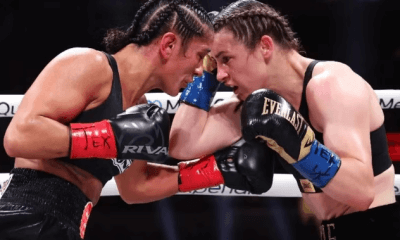
 Featured Articles3 weeks ago
Featured Articles3 weeks agoResults and Recaps from New York Where Taylor Edged Serrano Once Again
-

 Featured Articles1 week ago
Featured Articles1 week agoThe Hauser Report: Zayas-Garcia, Pacquiao, Usyk, and the NYSAC
-

 Featured Articles2 days ago
Featured Articles2 days agoOscar Duarte and Regis Prograis Prevail on an Action-Packed Fight Card in Chicago
-

 Featured Articles3 weeks ago
Featured Articles3 weeks agoResults and Recaps from NYC where Hamzah Sheeraz was Spectacular
-
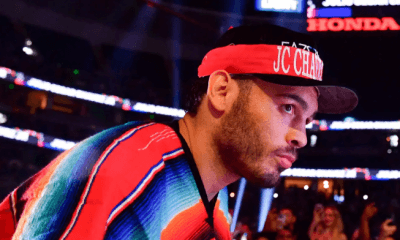
 Featured Articles4 weeks ago
Featured Articles4 weeks agoFrom a Sympathetic Figure to a Pariah: The Travails of Julio Cesar Chavez Jr
-
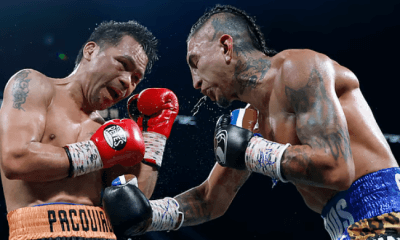
 Featured Articles2 weeks ago
Featured Articles2 weeks agoManny Pacquiao and Mario Barrios Fight to a Draw; Fundora stops Tim Tszyu
-
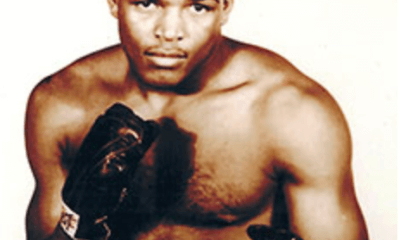
 Featured Articles4 weeks ago
Featured Articles4 weeks agoPhiladelphia Welterweight Gil Turner, a Phenom, Now Rests in an Unmarked Grave
-
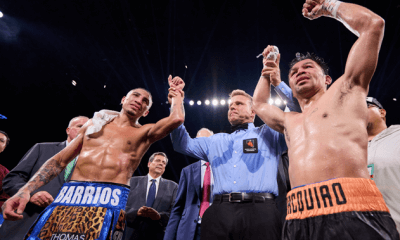
 Featured Articles2 weeks ago
Featured Articles2 weeks agoArne’s Almanac: Pacquiao-Barrios Redux















